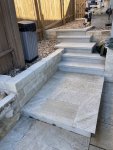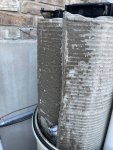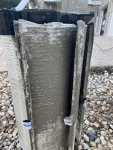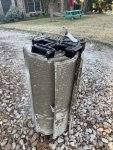- Jun 18, 2019
- 594
- Pool Size
- 30000
- Surface
- Plaster
- Chlorine
- Salt Water Generator
- SWG Type
- Pentair Intellichlor IC-60
I have a pool that was filled April 2020. Shortly after filling, I recorded the power usage at various flow levels of the pump. That's one nice angle about the VSF, it adjusts RPM to a set flow point.
Fast forward, and I've noticed the RPM and power usage (which I would think are related) has increased substantially to provide the same flow. What I can't make sense of is if I change to RPM settings, the before/current measurements make no sense as the same RPM produces less GPM but also less power. It seems to have recently gotten worse as water and air temps have decreased. Here's that data, I'll comment about one incident that is likely a contributor shortly after. As I provide this today, yesterday was 10-15F colder (air temp) and the same 30 GPM test was using over 700W.
When new:
30 GPM = 1,945 RPM = 404 Watts
2,750 RPM = 55 GPM = 1,215 Watts
Now:
30 GPM = 2,394 RPM = 676 Watts
2,750 RPM = 38 GPM = 1,043 Watts
Now with Filter Bypass (Recirc Mode)
30 GPM = 1,950 RPM = 410 Watts
2,750 RPM = 53 GPM = 1,196 Watts
Possibly contributing factors include:
1. Updated firmware a couple weeks ago to the Sept 2020 release. However, I noticed power usage was up prior to this.
2. Pehaps more restriction would cause more amperage to spin the same RPM, that would explain why the same RPM is producing less flow, but not sure why it's be less flow and less power for the same RPM.
3. Definitely contributor is, around June 10, I had to have some coping reinstalled. The crew that did this ended up filling my pool/spa with concrete dust as they had to grind the old adhesive down and make a smooth concrete platform to reapply the coping. It was a tedious 2-3 day chore to get this cleared up which included lots of pump time, draining the spa into the pool and then refilling from the pool. The robot helped tremendously, lots of brushing but astonishingly to me water got back to crystal clear quite easily (I really thought we were in drain/fill territory as a new pool owner). I immediately back-washed and obviously the water was dirty, but it ran clear reasonably quick after backwashing and rinsing about 5 times. I've since back-washed maybe 4 times. My pool otherwise stays SUPER clean as it's above ground and effectively above the trees. Lots of robot, daily scooping up of the few leaves/insects that get in there, etc. Unfortunately, I didn't record a pre-concrete-incident filter starting pressure as I never thought to record that. Since the incident, after back-washing, starting pressure has stayed at 18psi @ 2750 RPM. It literally doesn't go up at all given the pool stays quite clean. Maybe it's gone up 1 psi in two months. Each time I backwash, I never have to adjust the pressure dial since the pressure hasn't changed after the backwash. Reminding again, I don't recall my starting pressure before the concrete incident.
Every pool is different, I really wish I knew my starting pressure on the brand new filter. It's worth noting my pool equipment is on a higher elevation than my pool by a fairly notable amount 8' vertically higher than top of water, 16'+ from bottom drains to pump. Priming the pump the first time was quite an effort.
I'm going to do a full filter breakdown to rule out that (well my pool builder is since he made the concrete mess), clearly the filter adds pressure and requires the pump to work harder, but I'd think even in full bypass, it should outperform (less power) a brand new filter. I'll report back after, but considering things really haven't changed in the last month except it getting much colder, it seems the RPM and power usage has been going up in concert with colder air/water.
Pictures attached of equipment location to pool and some concrete cleanup pictures:
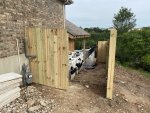
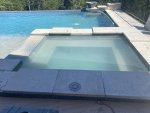
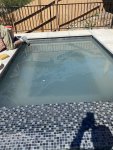
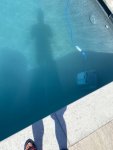
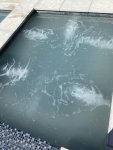
Fast forward, and I've noticed the RPM and power usage (which I would think are related) has increased substantially to provide the same flow. What I can't make sense of is if I change to RPM settings, the before/current measurements make no sense as the same RPM produces less GPM but also less power. It seems to have recently gotten worse as water and air temps have decreased. Here's that data, I'll comment about one incident that is likely a contributor shortly after. As I provide this today, yesterday was 10-15F colder (air temp) and the same 30 GPM test was using over 700W.
When new:
30 GPM = 1,945 RPM = 404 Watts
2,750 RPM = 55 GPM = 1,215 Watts
Now:
30 GPM = 2,394 RPM = 676 Watts
2,750 RPM = 38 GPM = 1,043 Watts
Now with Filter Bypass (Recirc Mode)
30 GPM = 1,950 RPM = 410 Watts
2,750 RPM = 53 GPM = 1,196 Watts
Possibly contributing factors include:
1. Updated firmware a couple weeks ago to the Sept 2020 release. However, I noticed power usage was up prior to this.
2. Pehaps more restriction would cause more amperage to spin the same RPM, that would explain why the same RPM is producing less flow, but not sure why it's be less flow and less power for the same RPM.
3. Definitely contributor is, around June 10, I had to have some coping reinstalled. The crew that did this ended up filling my pool/spa with concrete dust as they had to grind the old adhesive down and make a smooth concrete platform to reapply the coping. It was a tedious 2-3 day chore to get this cleared up which included lots of pump time, draining the spa into the pool and then refilling from the pool. The robot helped tremendously, lots of brushing but astonishingly to me water got back to crystal clear quite easily (I really thought we were in drain/fill territory as a new pool owner). I immediately back-washed and obviously the water was dirty, but it ran clear reasonably quick after backwashing and rinsing about 5 times. I've since back-washed maybe 4 times. My pool otherwise stays SUPER clean as it's above ground and effectively above the trees. Lots of robot, daily scooping up of the few leaves/insects that get in there, etc. Unfortunately, I didn't record a pre-concrete-incident filter starting pressure as I never thought to record that. Since the incident, after back-washing, starting pressure has stayed at 18psi @ 2750 RPM. It literally doesn't go up at all given the pool stays quite clean. Maybe it's gone up 1 psi in two months. Each time I backwash, I never have to adjust the pressure dial since the pressure hasn't changed after the backwash. Reminding again, I don't recall my starting pressure before the concrete incident.
Every pool is different, I really wish I knew my starting pressure on the brand new filter. It's worth noting my pool equipment is on a higher elevation than my pool by a fairly notable amount 8' vertically higher than top of water, 16'+ from bottom drains to pump. Priming the pump the first time was quite an effort.
I'm going to do a full filter breakdown to rule out that (well my pool builder is since he made the concrete mess), clearly the filter adds pressure and requires the pump to work harder, but I'd think even in full bypass, it should outperform (less power) a brand new filter. I'll report back after, but considering things really haven't changed in the last month except it getting much colder, it seems the RPM and power usage has been going up in concert with colder air/water.
Pictures attached of equipment location to pool and some concrete cleanup pictures:





Last edited:


